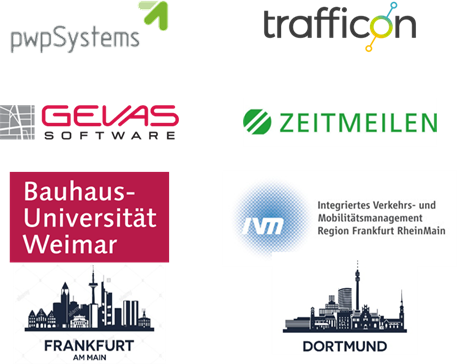
In the article ‘Strategic levers to work on to develop the Italian way to connected mobility‘, four strategic levers were described – build transparency and trust; build new business models; create shared value for all stakeholders; create innovation on collaborative initiatives between public and private actors to promote and foster the creation of a new mobility ecosystem.
In this article we have chosen to deepen and explore some of the examples related to the first strategic lever – Building transparency and trust -, presenting some key smart development projects in cities, both in Europe and overseas (USA).
As for European cities, the two emblematic cases are represented by the city of Frankfurt (in partnership with the city of Dortmund) and the city of Hamburg. Both case studies are located in Germany, and this should not come as a surprise: Germany has been committed for years to the development of new models of mobility management in cities through data and to the involvement of an increasing number of private actors in the creation of partnerships. Both municipalities – Frankfurt and Hamburg – have realised the potential of using data and creating synergies with private actors in order to develop new innovative mobility models with high added value for city users.
The German Federal Government’s strong commitment to promoting the transformation of transport systems in major cities stems from the increase in traffic and the steady rise in pollution linked to fine dust and nitrogen oxides. Connected mobility is one of the key tools for achieving the Zero Pollution objective of Vision Zero, together with the other two objectives Zero Accidents and Zero Congestion. In the German government’s vision, increased traffic and pollution have made it urgent to implement effective traffic management strategies and to create intelligent transport systems.
The digital transformation of the city of Frankfurt is characterised by the desire to evolve traffic management strategies into proposals for optimised roading in the city. The pilot project, called “SCHOOL“, involves eight public and private actors and is financed with a total budget of approximately 2 million Euro.

The project envisages the creation of a Mobility Data Space (MDS) to collect and exchange mobility data in order to enable the development of new offers to citizens and new traffic management strategies.
SCHOOL aims to make traffic in metropolitan areas more efficient and environmentally friendly by reducing polluting emissions. To this end, network technologies and new traffic management strategies have been implemented, following the logic of omnichannel management.
The operation of the system is based on the collection of data which are then used in specially developed routing applications (alternative routes) to get the end customer to destination faster. To promote user participation in the new mobility concepts, the SCHOOL project partners use a gamification and incentive system.
Within the SCHOOL project, solutions and operational models are developed in cooperation between public and private actors. Specifically, the city of Frankfurt plans to develop a system to collect traffic data and make them available on an MDS. Developers will have access to the data and will be able to propose new services to users in the transport [1]ecosystem.
A second example looks at the development of a new mobility model in Hamburg, the start of which was marked by the launch of a project to digitise mobility in urban and rural areas – a project supported by an investment of €21 million – funded by the German Bundesministerium für Verkehr und digitale Infrastruktur (BMVI) [2]. The “Real Lab Digital Mobility” is based on the initiative of the national Future of Mobility platform. The aim of the project is to create a digitally supported infrastructure that makes traffic safer, more comfortable and climate friendly.
To the present day, the project, called Reallabor Hamburg – RealLabHH, has more than 32 partners and involves the development and testing of innovative mobility offers in ten sub-projects ranging from mobility platforms to the testing of autonomous driving systems, from the use of micro-depots to reduce logistical traffic to the provision of on-demand shuttles[3].
According to the idea of the project promoters, a fundamental role will be played by the ability to involve citizens in the development and dissemination of new mobility ecosystems. Considering the high level of innovation – for example, the introduction of self-driving buses is planned – it will be necessary to understand citizens’ perceptions in order to develop mobility innovations in the city in consultation with users.
The goal is to complete the first pilots of the RealLabHH project by the end of 2021, and then to continue developing the city mobility of the future until 2030. It is therefore a project with both short-term objectives – like the quick wins defined by OCTO and The European House-Ambrosetti in the project “The Italian way to connected mobility” – and long-term ones. The promoters have in fact realised that the digital transformation of mobility cannot take place and be completed in a few years, but that it is necessary to work overtime to achieve functional and optimal results for both citizens and other mobility stakeholders.
Overseas, the case of the city of San José, in the heart of California’s Silicon Valley, was analysed.
The world looks to Silicon Valley as the primary source of the most creative and impactful technologies capable of radically innovating industries and transforming lifestyles. The City of San José aims to be a global leader in urban innovation.
According to the vision of the municipality of San José, a ‘smart city’ must be able to create an environment of experimentation in which new technologies and data-driven decision-making processes lead continuous improvement in the services offered to citizens.
The implementation of the Smart City will promote concrete benefits in the areas of security, sustainability, economic opportunities and quality of life for citizens. Based on this vision, the project to digitise the city of San José, recently initiated by Mayor Sam Liccardo, was [4] inaugurated.
The transformation of the city of San Jose is based on five key elements perfectly in line with the Vision Zero – Zero Accidents, Zero Congestion, Zero Pollution – promoted by OCTO and The European House – Ambrosetti:
- Safe city – creating a safe environment not only by reducing crime rates, but also by addressing those factors that can jeopardise the safety of citizens on a daily basis (e.g. promoting transport safety).
- Inclusive city – creating an accessible city (e.g. by removing architectural barriers)
- User friendly city – developing innovations that enable citizens to easily use all the services offered by the city
- Sustainable city – creating an urban ecosystem with reduced impacts on the environment
- Demonstration city – enabling experimentation (in various fields, including mobility) within the urban environment, supporting the development of innovative economic activities.
In developing a safer city, attention has also been paid to mobility. In particular, one of the goals is to reduce road accidents and fatalities through connected infrastructure, data analysis and machine learning; tools that can optimise traffic systems, identify high accident rate intersections and target prevention efforts, for example by using behavioural knowledge to reduce speeding along corridors with high accident rates with injuries.
Its location in Silicon Valley is bound to foster the city’s propensity for innovation and experimentation. San José intends to develop innovation in the city’s transport system, focusing in particular on experimenting with new products and services – such as autonomous vehicles – and new mobility models capable of drastically improving transport and easing traffic congestion in the near future.
To achieve these goals, San José decided to build an Internet of Things platform integrated with transport infrastructure to improve safety and mobility and to optimise the urban system by collecting real-time data through smart sensors.
Another key element in the vision of the city of San José is the participation of innovative actors in the co-creation of a new city environment. To do this, the city has decided to create avenues for startups and other innovation players to easily access opportunities to develop pilot projects and test new products and services with the city; we are talking about – for example – “demo days” designed to highlight the most innovative “smart city” companies in Silicon Valley or sponsoring public competitions that encourage crowdsourcing of innovative solutions to civic challenges.
To achieve all these objectives, the project promoters have identified a number of “necessary” actions to be implemented by the city’s key stakeholders:
- Investment in human resources, creating skills upgrading programmes and hiring technology experts directly from the tech industry.
- Definition of a risk management model that, in addition to risk management, provides space for “trial and error” processes in the development of new ecosystem models of innovation.
- Creation of an innovation and digital strategy section within the City Manager’s office to drive and evaluate results and strategically invest in the technology infrastructure.
- Monitoring of the results achieved in order to define the strategic actions to take.
- Facilitating private sector collaboration with the municipality. For example, San José has created an office of strategic partnerships to provide a single point of contact with philanthropic and private sector organisations.
The elements described above are considered key in the vision of OCTO and The European House – Ambrosetti to give life to the “Italian way to connected mobility”.
In particular, the importance of the Public Administration in creating favourable environments for experimentation was highlighted on several occasions during the process of involving leading national stakeholders, not only to create and enable new paradigms for smart cities, but also as a concrete form of support for the local economic fabric’s ability to innovate and for the territories’ ability to attract investment in innovative sectors. In addition, these experiments could provide inspiration for defining models of public-private collaboration and creating synergies between industry and city ecosystems.
In the next article in this series, some examples of future mobility models, identified in the global context, will be described, with the aim of providing indications on the development directions of various mobility ecosystems.
[1] Source: elaboration by The European House – Ambrosetti on the website of the Federal Ministry of Transport and Digital Infrastructure, Germany, 2021.
[2] Source: elaboration by The European House – Ambrosetti on RealLabHH website, 2021.
[3] Ibid.
[4] Source: The European House – Ambrosetti elaboration on San Jose Smart City website, 2021.
Authors:
Alessandro Viviani : Senior Consultant – Innotech Hub
Corrado Panzeri : Associate Partner – Head of InnoTech Hub
The European House – Ambrosetti